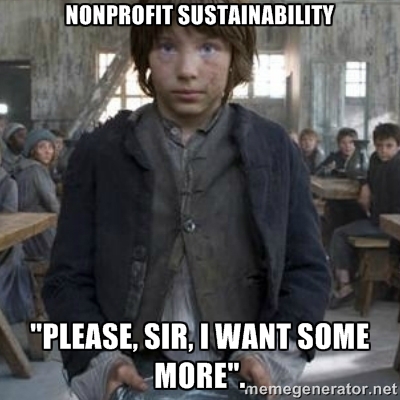 The last few weeks have been rough. Not only did the baby grow his first tooth and got an ear infection and has been miserable, but also my lucky bamboo, which I got to boost the feng shui in the office, mysteriously turned yellow and died.
The last few weeks have been rough. Not only did the baby grow his first tooth and got an ear infection and has been miserable, but also my lucky bamboo, which I got to boost the feng shui in the office, mysteriously turned yellow and died.
None of that, however, compared to getting news that one of the schools we partner with didn’t get the grant that it applied to. I helped them to write this massive, 30-page narrative, sitting at the principal’s desk and typing away as she ran in and out of her office to deal with one situation after another. The grant was painful. It was like taking a pint of kumquats, freezing them overnight, putting them into a gym sock, running the gym sock though some poison oak, and then beating yourself in the face with it while watching Star Wars The Phantom Menace, that’s how painful it was. (I helped another school last year to write the same grant, and wrote about how awful that was).
We wrote this grant for several days. This is a school with 95% kids of color, 85% low-income, and this was their third time writing this grant and failing to get awarded. It was a devastating blow for a really great school. “I’ll buy you a drink,” I told the principal; we both felt like crap.
A few days later, I ran into one of the executive board members, “Frank,” who approved the decisions. I told him the grant award system was messed up and he needed to change it. “Well,” he said, “there are always winners and losers. And we need to focus on schools who have principals who are accountable and taking lead to improve their schools.”
As much as I love the US, we have some major things to improve on. One of those things is this zero-sum game that we play, and it often manifests in the form of “accountability,” a catch-all concept that everyone now uses because it makes them look smart and responsible. Accountability now equates with excellence and quality and bald eagles and apple pie.
Unfortunately, this concept has been thoroughly misused, wielded as a tool to perpetuate many crappy and unjust systems.
At a panel I was on, the topic was parental engagement. “We can talk all we want about all sorts of things,” said one of the other speakers, “but at the end, it comes down to parental accountability. Parents need to be responsible for their kids’ learning! They need to read to their kids and make sure they do their homework!”
Yeah, said the room, clapping, that’s the American Way!
“I agree,” I said, “parents should be involved in their kids’ education.” But, I pointed out, many of them don’t have the language skills, or they are poor and work several jobs. And then because they are poor, they tend to go to struggling schools, and those schools don’t have translation services, or any staff who can spend time with the parents, so even if a parent really wants to be engaged, they come to school and there is no one to help them. So if we want parents to be accountable, provide them the resources they need first.
We have a very punitive sort of mindset, and oftentimes it makes no sense. Let’s punish the schools that don’t do well by taking away or not giving them the resources they need. THAT will incentivize them to get better, those lazy, good-for-nothing schools who have no accountability.
Also, let’s force low-income schools to write painful 30-page grants to compete for these funds that are designed with equity in mind to help struggling schools with high numbers of low-income students. Grants that are so painful it’s like taking a mason jar, filling it with apple cider vinegar, running through a blackberry thicket, then pouring the vinegar all over yourself. The best-written grants should be awarded, because that’s accountability. Let’s ignore the fact that the schools that are most struggling, and thus most in need of these funds, are probably the ones that have the most challenges writing these grants.
People, even well-intentioned people like “Frank”, use “accountability” as a crutch to not have to deal with the much harder task of achieving equity. Why spend five times more effort to define and find the most struggling schools, work with them to develop a strong plan to support their students to achieve, and provide them with funding and guidance to succeed? Why do all that when you can make all the schools write a sadistically burdensome grant, grade them on a 100-point scale, and pick a school that scored 87 points over a school that scored 85 points? Your process is clear and “accountable,” you’re forcing the schools to be “accountable,” and no one can yell at you for being unfair.
People who believe that competition and the focus on accountability will lead to equity are deluding themselves. They believe everything should be like the Olympics, where those who perform the best should get the gold. Most of us, though, enter into the field of nonprofit or philanthropy because we know the games are screwed up, and our job is to do whatever we can to bring balance by making conditions equal. How can you give someone a gold medal for Alpine skiing, for instance, when they have two skis and the other skiers have only one ski, or a broken ski, or there is not enough snow on their track? Let’s focus on making sure everyone competes under the same conditions before we reward the best performers.
Even if conditions are equal, though, sadly the competition will still not be fair. That’s because everything is relationship based. Those who have the best relationships will always get ahead, and poor families, and communities of color, and struggling schools and scrappy nonprofits will seldom have the same level of relationships with influential people.
That’s why our work is important. We above most people understand that equity comes first. Sometimes, though, we also forget, and we also fall into the accountability trap.
If we want equity, we must start with equity. And there are instances where it is working. Finland, for example, has become one of the best school systems in the world, if not the best. They focus on ensuring there is equity first. In fact, they don’t even have a word for “accountability.” There are few standardized tests, for example, and they don’t make their principals spend 80 hours writing a grant to get the resources they need, a grant so awful it’s like taking a handmade quilt, gathering crazy ants onto it, then wrapping the quilt around yourself while listening to Passenger. They focus first on making sure every student has the same opportunity. And yet they are excelling. In comparison, Norway, with a similar homogenous population, has bought into this system of competition, punishment, and accountability, and they are not doing nearly as well. This is only one example, but it is a strong one.
Now that I’ve become a parent, I think a lot about how families are structured and what kind I would like mine to be. Imagine a family that is ultra competitive, where children are in constant competition with one another and rewarded by their parents. “John got 5 A’s this quarter, so we’re going to take him to Disneyland, yay! Have some more food, son, you deserve it. The rest of you, you got B’s, you need to shape up. Jimmy, I don’t care that you got mugged twice last month while walking home. Toughen up and stop whining. Be a man like John here.” (Sadly, I actually know some parents who are like that).
Most of us can see how awful it would be to live in such a family. But this is what our society is increasingly becoming like.
Many of us continue to do this work because we believe there shouldn’t be have to be winners and losers all the time, especially when we are talking about kids. All of them deserve a chance to succeed, and it pisses me off when idiots wield “accountability” as a reason to justify their thoughtless decisions. If we want EVERYONE to succeed, and not just a select few, then we must ensure everyone has the same opportunities. When it comes to accountability and quality and equity, it is not a chicken-and-egg argument. It is equity that will lead to quality and accountability, not the other way around.







